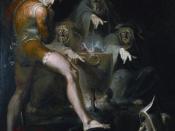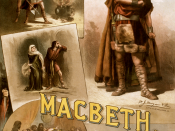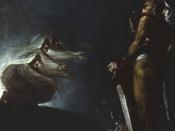In the following critical essay, one aspect of William Shakespeare's Macbeth will be explored and be explained. This aspect is that of the three Weird Sisters. These three 'secret, black, and midnight hags' (Mac. IV.i 47), hardly distinguishable as humans, serve a huge dramatic function in the play. Closely looking at Macbeth, one can distinguish the many functions that they serve in the play. The role of the three Weird Sisters in the play Macbeth is to generate imagery, mood, and atmosphere and to serve as the equivocation that will bring Macbeth, Thane of Glamis, to his downfall.
The History of Macbeth
During the reign of James I of England in the 17th century, William Shakespeare wrote Macbeth. This history - tragedy was about the Scottish Thane Macbeth who had murdered his cousin King Duncan I to possess the title of king of Scotland. In Macbeth, Shakespeare exposes the internal forces of the human mind that eventually brings the ambitious Macbeth and Lady Macbeth to their downfall.
James I was pleased with this masterpiece because it included Banquo, Macbeth's companion. In the beginning of the play, Macbeth and Banquo are greeted by three witches, which proclaim Macbeth as king and Banquo as 'thou shalt get kings, though thou be none.' (Mac. I.iii 67) This is significant through the fact that James was a direct descendant of Banquo.
One might ask why Shakespeare included witches in Macbeth in the first place, not fearing the criticism and the hatred of witchcraft in Europe. An interesting fact of 17th century England that Shakespeare was living in was the overwhelming fascination of the supernatural. Elizabethans of all classes had believed in the power of supernatural agencies. The most sensational aspect of this Elizabethan superstition was the belief in witchcraft, with James I as...


